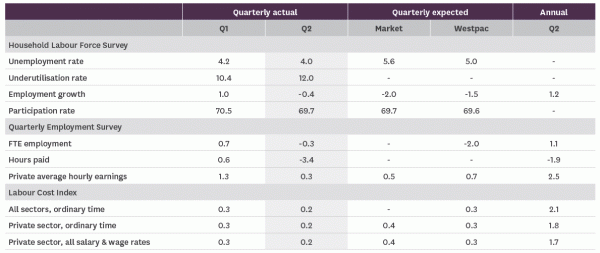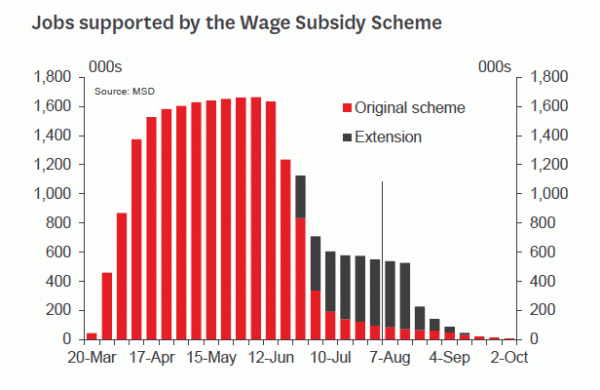- Labour market conditions were stronger than we expected in the June quarter.
- The number of people employed has fallen, but by less than we forecast – and much less than was feared at the start of the lockdown.
- The wage subsidy scheme has played a crucial role in avoiding major job losses. Employers have adjusted by reducing hours and pay instead.
- We still expect a rise in unemployment in the coming quarters. But it looks like the peak will be lower than our previous forecast of 8%.
It was always clear that New Zealand’s response to COVID-19 would create some challenges in measuring the true state of the economy. And the headline from today’s labour market surveys – a fall in the unemployment rate to 4% – is so counterintuitive that the temptation may be to dismiss the results altogether. But that would risk throwing the baby out with the bathwater.
The details of the surveys paint a fuller picture, and the bottom line is that labour market conditions are stronger than we expected – and much better than we feared in the early days of the COVID-19 response. New Zealand’s early containment and reopening of the economy, and the Government’s wage subsidy scheme, have been crucial in avoiding the surge in unemployment that we have seen in some other countries.
According to the Household Labour Force Survey (HLFS), the unemployment rate fell from 4.2% to 4.0% in the June quarter, against market forecasts of an increase ranging from a low of 5% (our estimate) to as high as 6.4%. The critical factor here, as we noted in our preview, is that the standard definition of ‘unemployed’ is those who are actively seeking work. That wasn’t really a practical option while the country was under lockdown conditions.
Indeed, Stats NZ provided additional detail showing that during the Level 4 lockdown in April the reported unemployment rate was just 2.7%. That figure rose as the country eased its restrictions, and by the time we reached Level 1 in June – at which point there was nothing to inhibit job-hunting – the unemployment rate had risen to 4.9%.
The broader measures of labour market tightness provide a better indication of recent conditions. The underemployment rate, which includes those working part-time who would like to work more hours, rose from 7.5% to 8.5%. The underutilisation rate, which also includes those who would like a job but weren’t actively looking, rose further again from 10.4% to 12.0%. That was the biggest quarterly increase since this measure began in 2004, though the level is still well below where it sat in the wake of the Global Financial Crisis.
Definition issues may have clouded the unemployment rate, but not so for the measures of employment. Notably, these were quite a bit stronger than we or the market expected. Employment in the HLFS fell by 0.4%, against our forecast of a 1.5% decline. (Stats NZ’s monthly employment indicator, based on income tax data, had suggested a 1% fall, but we shaded our forecast a bit lower.)
Meanwhile, the Quarterly Employment Survey (QES) measures of filled jobs and full-time equivalent employment saw similarsized declines. We saw more risk of a sharp decline in jobs in this survey – unlike the HLFS, which represents an average over the quarter, the QES was held in mid-May. At the time the country had just moved from Alert Level 3 to 2, and activity was still quite depressed.
These results emphasise the critical role that the wage subsidy scheme has played in keeping people attached to the workforce. The impact of the COVID-19 lockdown has been more diffuse than we’ve typically seen in recessions: instead of a wave of job losses, employers were able to keep many workers on at reduced hours and/or pay.
One of the conditions of receiving the subsidy was that employers had to keep paying workers at least 80% of their previous pay, even if they cut their hours by more than that. This condition shows up clearly in the surveys: total hours paid fell by 3.4% for the quarter, while total hours worked fell a massive 10.4%. The latter gives a better idea of the drop in GDP that we’re likely to see when the figures are published in September; we’re expecting a 13% drop (and that is at the smaller end of market forecasts).
Not surprisingly, wage growth was limited during the quarter. The Labour Cost Index (LCI) rose by just 0.2%, all of which was due to the minimum wage hike in April. Pay cuts during the lockdown were captured in the LCI only if a lower hourly rate was explicitly negotiated; this doesn’t appear to have been a common approach.
Outlook.
We still expect unemployment to rise in the coming quarters. The gap between the unemployment rate and the broader utilisation measure is likely to resolve itself next time – there are no longer any impediments to actively looking for work. And those who are involuntarily working part-time won’t remain so for long – either their hours will be restored, or their jobs will disappear.
The big unknown is what will happen as the wage subsidy scheme expires. We estimate that around 450,000 workers are still receiving the subsidy, with most of them rolling off by the end of August. What we don’t know is how many of those jobs are at risk once the subsidy ends, but they could potentially dwarf the 11,000 jobs lost to date.
That said, the starting point for the labour market is clearly stronger than we expected. At the start of the Level 4 lockdown we estimated that the unemployment rate could reach 9.5%, and many market forecasts were in the double digits. We later revised our forecast peak down to 8%, and on the basis of today’s results and other indicators, we’re inclined to go even lower.





















